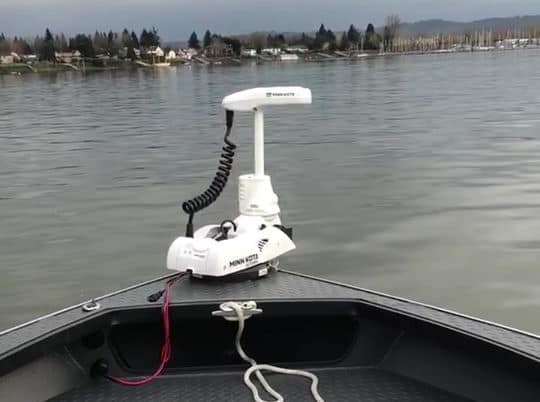Trolling motors are very, very, very important if you love to fish like me. But, deploying them manually every time you mount your boat may be a boring and humdrum task. So, how about using a self deploy trolling motor?
But, wait, what is a self-deploy trolling motor? In this article, I will try to erase all your confusion and tell you everything which you need to know about self-deploy trolling motor before buying one. Without any further delay, let’s start.
Note: most links in this article are Amazon.com Affiliate links, see Affiliate Disclosure, thank you.
What is a self deploy trolling motor?
Many of you are familiar with a regular electric trolling motor, a self-contained electric motor that is for propelling boats consistently at slow speeds or controlling the direction of movement of boats. But what is a self-deploy trolling motor? Well, it’s a high-end electric trolling motor that can deploy automatically by a remote controller.
Traditional electric trolling motors have to be deployed manually. This feature can come in very handy especially for people with disabilities or boats where deploying the motor manually can be a challenge. Also, in rough water, getting on the front of your boat to deploy or stow your motor can be outright dangerous.
Check out our article on the advantage of using a bow mount electric trolling motor over a transom mount.
Self-deploy trolling motors and disabilities.
We wanted to cover this topic because people with bad backs, lifting injuries or as we get older need to make allowances for these issues. Lifting any item on your boat can be a problem if you suffer from any of these issues.
We would hate for you to not be able to enjoy a day on the water because of an injury. A self deploy trolling motor could make all the difference by eliminating your need to repeatedly lift and lower your motor.
As a personal note, I am getting older and after working a long week the last thing I want to do is lift my trolling motor ten times when I am out for “a relaxing day on the water.”
How to install a self-deploy trolling motor?
Modern-day self-deploy trolling motors are very easy to install. But before that, you have to bring some tools to install your trolling motor to your boat.
You will need:
- Drill
- 5/16″ Drill Bit
- 7/16″ Wrench
- 9/16″ Wrench
- Wire ties
- Philips screwdriver
- Flat blade screwdriver
- A friend
Steps to install a self-deploy trolling motor
Before we start the step-by-step instructions, we would like to point out that having a helper is very important when marking the holes and mounting the motor.
- Remove the four side plate screws. Remove side plates to access the mounting holes.
- Remove the two 5/16″ clips retaining the extension damper. Remove the extension damper to expose the front left mounting hole.
- Place the motor on the bow of the boat. It is recommended that the motor should be kept close to the centerline of the boat. Make sure the slot on the underside of the mounting base is aligned with the rub rail of the boat.
- Once the motor is positioned correctly, mark the points where you have to drill. Make sure that the area under the trolling motor mounting area is clear and strong enough to drill holes and install nuts and washers.
- Drill through the marked points with the 5/16″ drill.
- Mount the trolling motor using hex head bolts and clipped washers provided. Clipped washer should have the flat portion against the mounting base.
- Reinstall the extension damper with the shaft facing towards the interior of the boat. Reinstall the e-clips.
- Replace the side plates and side plate screws by hand using a Phillips screwdriver.
- Connect the motor to power.
- Turn the power on and deploy the motor using the stow/deploy button.
How other types of trolling motors are deployed?
Trolling motor companies are very creative. There are many ways to deploy a trolling motor manually, but we will cover two of the most common methods which are used for deploying:
Lever- The MotorGuide Xi5 Wireless Trolling Motor – Saltwater, Bow Mount uses this procedure for deploying. In this process, you have to manually press down on the deploy release lever with one hand or one foot while holding the motor with the other hand and sliding it in the water. Stowing the motor is the same, but after you release the lever, you lift and pull the motor towards yourself. You can adjust the motor depth by adjusting the column to the desired level. Many other models for other manufacturers function the same way, like MinnKota Terrova.
Cord- The Garmin Force, 80/100#, 50″, 24/36V, Foot Steer can be deployed by this procedure. In this type of deployment process, once you adjust the chord, you can pull it to release and deploy the motor and stow the motor in the same manner. This process is easier to use than the lever process. Many other models for other manufacturers function the same way, like MinnKota Fortrex.
Advantages of self-deploy trolling motor
Self-deploying electric trolling motors are much better than manual motors. While these motors are loaded with high-end features, their biggest and most important feature is their self-deploy function.
The self-deploy feature allows you to stow, deploy or trim your motor with the touch of a button on the remote. So you don’t have to worry about falling overboard and injuring yourself while working with your trolling motor.
Minn Kota tried this feature years ago in a motor named Genesis but that was a failure. Now, technology has changed and engineers have worked very hard and engineered this feature in a very straightforward manner. Engineers have used as few moving parts as possible and also used extremely durable components.
And if the auto stow/deploy function fails somehow, there is also a manual deployment feature. So self-deploy trolling motors are perfect for all of your needs.
The Minn Kota line of self-deploy trolling motors also comes with GPS and iPilot features standard, which are not available in all regular trolling motors. Using a GPS motor is very necessary if you want to raise your fishing experience to a whole new level.
Disadvantages of self-deploy trolling motor
Now it’s time for the cons! We haven’t noticed any mentionable downsides in the self-deploy trolling motors. But you may find their prices to be a bit much, which can’t be afforded by everyone. But, if you can afford them, then there are no other specific reasons for not buying one.
DC Alternator Chargers are a must for self-deploy trolling motors
What is a DC alternator charger? This is a charging device that you install on your boat, similar to an onboard battery charger, to charge your trolling motor batteries while running your boat’s main motor.
The charger is connected to your main motor battery, trolling motor batteries, and main motor ignition. When you run your main motor, the MK-2 directs 10 amps per battery to the trolling motor batteries.
Most users don’t run the main motor enough to charge their battery banks substantially. If you look at the big picture, a few amps of power could add an hour to your fishing day.
The reason you need the MK-2 for self-deploy trolling motors is that if your battery bank runs low, your trolling motor will shut down. When your trolling motor shuts down, your fishing day is over but wait, there is more.
On a self-deploy trolling motor, you need to charge your battery to stow your motor. The MK-2 is the answer for your 24-volt self-deploy trolling motor.
Suppose you start your main motor and turn up your ideal while cleaning up your boat from your fishing day. After a few minutes, you will have a surface charge in your trolling motor batteries and be able to stow your trolling motor.
Click here for our article on Boat DC Alternator Chargers.
Click here to see the MinnKota alternator charges on Amazon.com
What people are saying about self-deploy trolling motor?
It seems that people are quite impressed by this new and innovative device. We hear lots of positive feedback regarding the self deploy trolling motors. We have noticed that there is only one bad review on Amazon against this product.
We read an interesting story on the internet about a self deploy trolling motor. The story goes that a man parked his boat on the coast and used the spot lock feature of his trolling motor to keep the boat fixed in its spot.
Then he went to a nearby shop to buy something. At that time, a man came to him. He asked pointing at the boat, “Is it your boat? It is stuck in the sand.” The man was very shocked because his boat was very heavy and moving his boat from the wet sand would be a very difficult task.
He ran to his boat and then he realized that it was not stuck because of sand but because of the spot lock feature. Many people were amazed by this incident — even a woman filmed the spot lock mechanism of the trolling motor.
Crazy, right? So, you can see that the self-deploy trolling motors have lots of fans, but we have heard some bad reviews against their enormous price.
Overview of the MinnKota Ulterra Riptide 80

The MinnKota Ulterra automatically deploys and stows by pushing a single button on the i-pilot remote. This motor is top of the line and loaded with features besides the deploy and stow. No longer do you need to trim your motor by hand when fishing shallow water or weeds, just push a button. If you want to fish the Ulterra on a boat in the style of a bass boat, you can buy the optional foot pedal (sold separately).
The Minn Kota Riptide Ulterra comes in many sizes, but the model we are discussing features 80 pounds of thrust (24 volts). Additionally, this motor includes all the mounting hardware and lead wires.
Pros:
- Self deploy and Power Trim feature
- Spot lock with Jog
- 24-volt system with 60-inch shaft
- Advanced iPilot link GPS control
- Fully saltwater and shock-resistant mechanism
- 2 year warranty
- Wireless remote control
- Lightweight and easy to use
Cons:
- Price
This self-deploy trolling motor is a beast. It makes controlling your boat so easy. The auto stow/deploy feature is its best feature, which can’t be seen in any other regular trolling motor. Minn Kota’s iPilot link remote control (link remote is an optional upgrade) also adds to its greatness. We highly recommend buying this product. Its high price is the only thing which may be a downside.
Click here for our full review of the MinnKota Ulterra
Check out the price on Amazon.com
Conclusion
Self-deploy trolling motors are one of the biggest innovations in marine technology. Now that this motor has been out for a few years, all the bugs are worked out.
So, should you buy one? We say if you’ve got the money, have a bad back, or just like the latest and greatest things, then there is no reason not to go for it!



